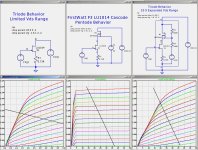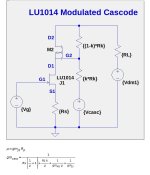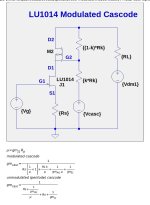I have been looking at the LU1014D cascode behavior and found an interesting "modulated cascode" circuit that preserves triode behavior and expands the Vds (and power) range of the composite SIT-like device.
The LU1014D has triode-like (SIT) behavior but suffers from a 24V source-to-drain voltage range and limited power dissipation capability. These limitations can be overcome by cascoding the device as in the FirstWatt F3 and more recently the LuDEF (https://www.diyaudio.com/community/threads/ludef.369990/post-6588632) and the LuFo Amp (https://www.diyaudio.com/community/threads/lufo-amp-39w-se-class-a-from-28v-rail.372679/post-6665040). However, all of those cascode circuits result in pentode behavior of the resulting circuit.
The three columns of the image below show:
The LU1014D has triode-like (SIT) behavior but suffers from a 24V source-to-drain voltage range and limited power dissipation capability. These limitations can be overcome by cascoding the device as in the FirstWatt F3 and more recently the LuDEF (https://www.diyaudio.com/community/threads/ludef.369990/post-6588632) and the LuFo Amp (https://www.diyaudio.com/community/threads/lufo-amp-39w-se-class-a-from-28v-rail.372679/post-6665040). However, all of those cascode circuits result in pentode behavior of the resulting circuit.
The three columns of the image below show:
- The LU1014 degenerated by 0.73 ohms source resistor, showing triode behavior.
- The LU1014 cascode of the FirstWatt F3, showing pentode behavior because of the constant voltage cascode.
- The LU1014 with a "modulated cascode", showing triode behavior almost identical to the degenerated LU1014, but over a 10X expanded Vds range.
Attachments
Practically cascode transformed from common arrangement to Schade arrangement, and that dominating compound transfer characteristic
good work
I remember Papa dealing with modulated cascodes here and there, last one connected to development of XS amps; though, does it ended in production circuit, I don't know
(I didn't expected any triodish residues in LuDEF, no source resistor under Lu, being interested strictly in pure transfer characteristics of OS elements)
edit: it would be interesting to compare your solution in F3 directly
good work
I remember Papa dealing with modulated cascodes here and there, last one connected to development of XS amps; though, does it ended in production circuit, I don't know
(I didn't expected any triodish residues in LuDEF, no source resistor under Lu, being interested strictly in pure transfer characteristics of OS elements)
edit: it would be interesting to compare your solution in F3 directly
There's been some concern and observation of high frequency oscillation in LU1014D in cascode. Does your new design address that issue?
Good question. Can you point me at relevant posts?There's been some concern and observation of high frequency oscillation in LU1014D in cascode. Does your new design address that issue?
The DIY F3 builder’s thread had some comments on this. I think I read some comments on cascoding elsewhere but I’m on my phone right now so searching links is difficult.
What's wrong with the penthode mode when the Id vs Vgs is already almost perfectly linear ?
How does the effective transconductance compare between penthode mode and extended triode mode ?
Patrick
How does the effective transconductance compare between penthode mode and extended triode mode ?
Patrick
A Schade arrangement has feedback to the gate of the LU. This arrangement has feedback to the drain of the LU through the cascode.Practically cascode transformed from common arrangement to Schade arrangement, and that dominating compound transfer characteristic
...
The small-signal behavior of a SIT can be expressed as:
ΔId=gm*ΔVgs+ΔVds/Rd, where Rd is the drain resistance (counterpart to triode plate resistance).
1/Rd can be thought of as a transconductance relative to the drain to source voltage.
Would you mind sharing the lu1014 model that you're using? I've seen a few models out there, but I'm not sure how reliable they are. Many thanks.
It depends on whether you are trying to get the effect of a triode-like amplifier rather than a pentode.What's wrong with the penthode mode when the Id vs Vgs is already almost perfectly linear ?
How does the effective transconductance compare between penthode mode and extended triode mode ?
Patrick
Here is a way to compute the "extended-triode" transconductance:
Attachments
https://www.diyaudio.com/community/threads/ld1014-spice-models.70008/post-867655Would you mind sharing the lu1014 model that you're using? I've seen a few models out there, but I'm not sure how reliable they are. Many thanks.
https://www.diyaudio.com/community/attachments/lu1014-zip.60368/
It depends on whether you are trying to get the effect of a triode-like amplifier rather than a pentode.
My very limited understanding :
The reason for a triode-type circuit is that it gives you a linear characteristics of Id vs Vgs, as opposed to (largely) parabolic for a pentode-like FET device.
But this linear characteristic is already achieved in the F3-type cascode of the LU1014.
IMHO, making the Id further dependent on overall Vds also means, more sensitive to power rail noise (in a follower type circuit).
And usually with reduced transconductance.
Patrick
You are correct about rail sensitivity and reduced transconductance.IMHO, making the Id further dependent on overall Vds also means, more sensitive to power rail noise (in a follower type circuit).
And usually with reduced transconductance.
In my previous post showing the "extended-triode" transconductance, I forgot to include the equation for unmodulated (pentode) mode:
Attachments
So what is the gain ?
Even better linearity, or more extended linear current range ?
Best regards,
Patrick
Even better linearity, or more extended linear current range ?
Best regards,
Patrick
I do not know if there is any gain. I thought it was an interesting way to extend the Vds range of the LU1014D while maintaining the triode behavior.
The "normal" cascode with pentode behavior has an interesting property I had not considered; it presents a (nearly) 0 ohm load line to the LU thus making the LU insensitive to the load impedance seen by the cascode.
The "normal" cascode with pentode behavior has an interesting property I had not considered; it presents a (nearly) 0 ohm load line to the LU thus making the LU insensitive to the load impedance seen by the cascode.
I do not have a complete design. As Patrick says, there might not be a good reason to use it vs. the "ordinary" cascode,
This is what I published 5 years ago for the Zen-V9-similar "penthode-mode" cascode optimised for 200mA bias.
Real measurements, not simulations :
https://www.diyaudio.com/community/threads/zen-variation-9.317131/post-5384547
The only thing that bothers me is the high-ish value of the source resistor, which reduces the effective transconductance.
The curve for ZV9 circuit at 1.3A bias looks essentially the same, be it at higher current.
Cheers,
Patrick
Real measurements, not simulations :
https://www.diyaudio.com/community/threads/zen-variation-9.317131/post-5384547
The only thing that bothers me is the high-ish value of the source resistor, which reduces the effective transconductance.
The curve for ZV9 circuit at 1.3A bias looks essentially the same, be it at higher current.
Cheers,
Patrick
Move it to the drain😉The only thing that bothers me is the high-ish value of the source resistor, which reduces the effective transconductance.
What are the gate-voltage steps in these curve sets? It's probably in the SPICE diagrams, but I don't speak SPICE...The three columns of the image below show:
The black lines show 8 ohm load lines.
- The LU1014 degenerated by 0.73 ohms source resistor, showing triode behavior.
- The LU1014 cascode of the FirstWatt F3, showing pentode behavior because of the constant voltage cascode.
- The LU1014 with a "modulated cascode", showing triode behavior almost identical to the degenerated LU1014, but over a 10X expanded Vds range.
- Home
- Amplifiers
- Pass Labs
- LU1014D Modulated Cascode


